
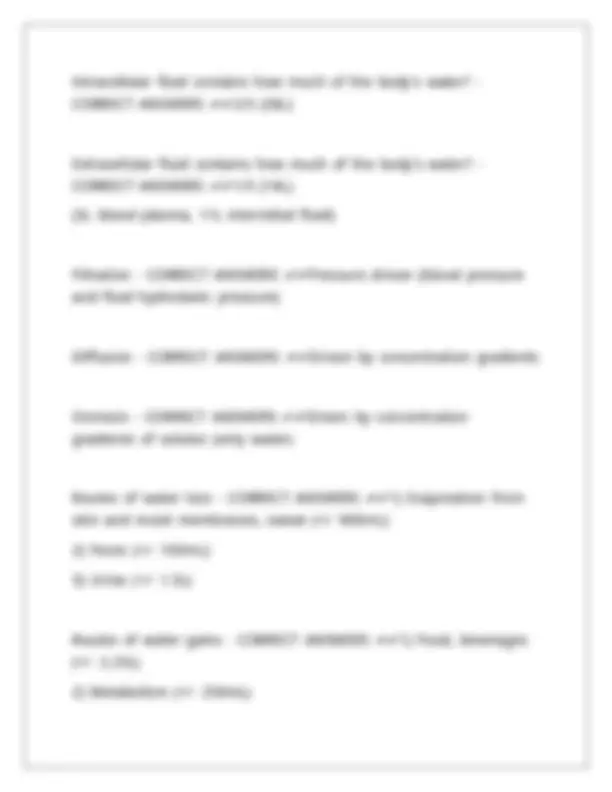
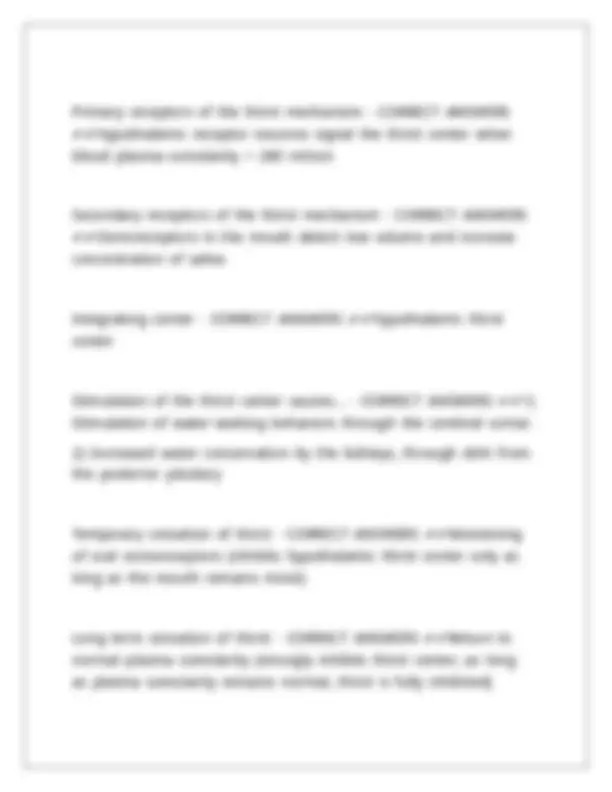
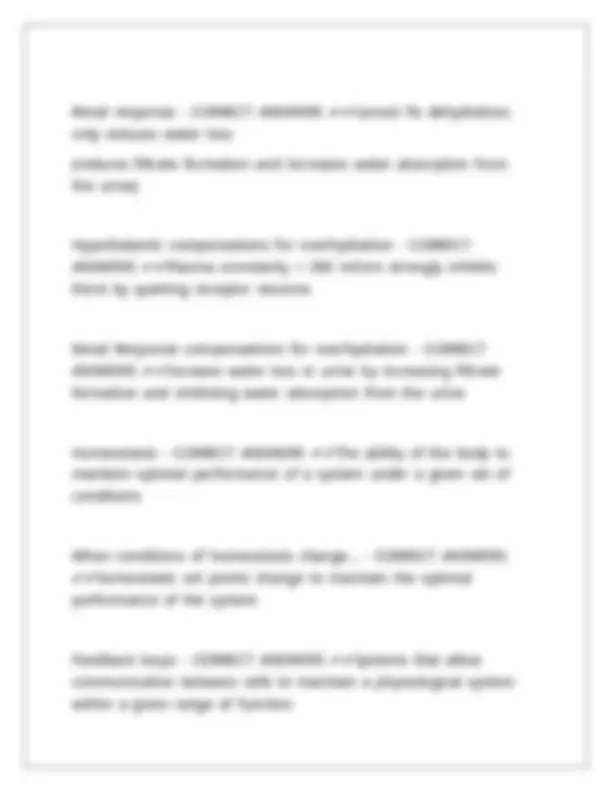
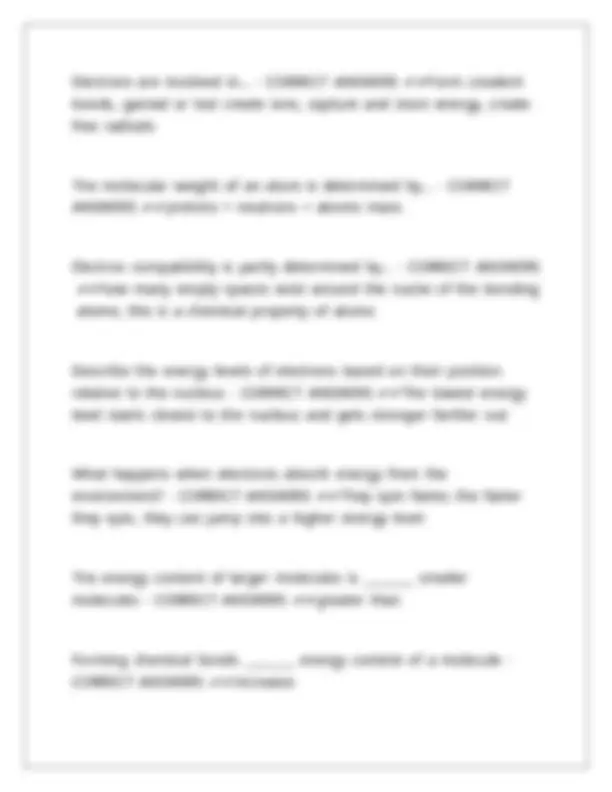
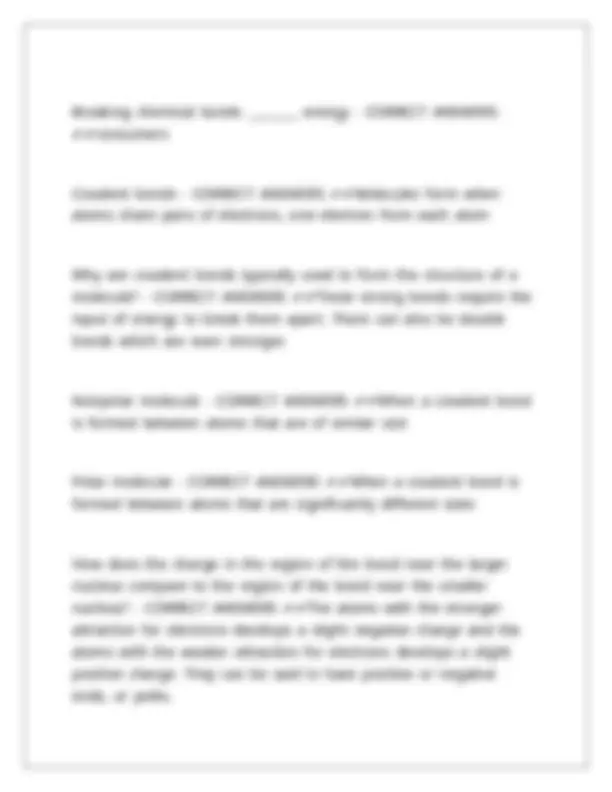
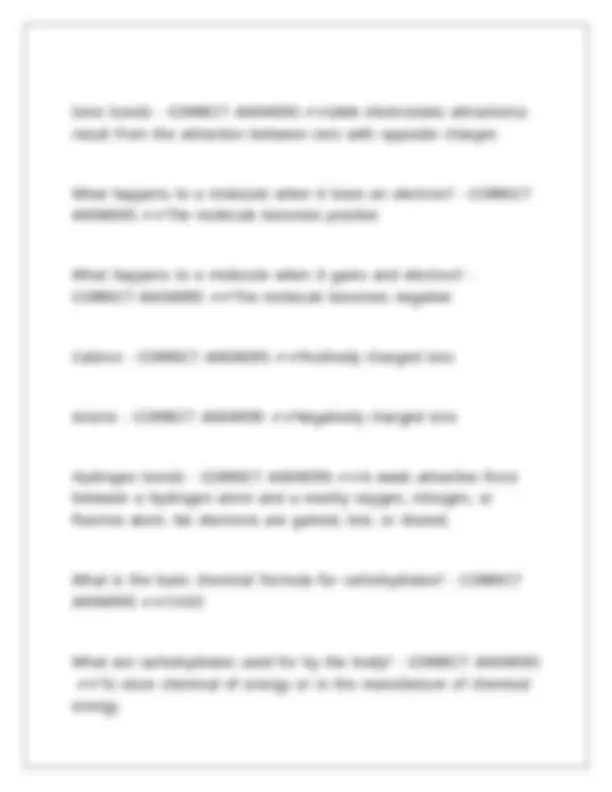
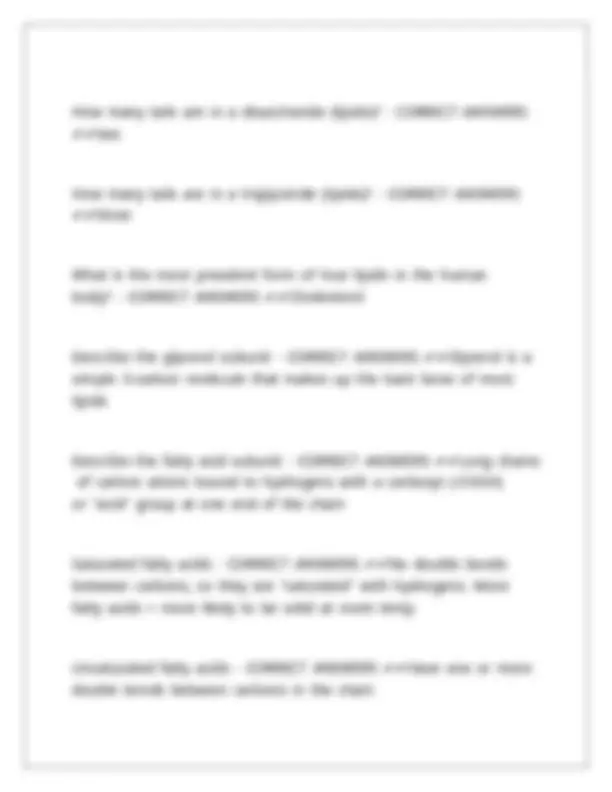
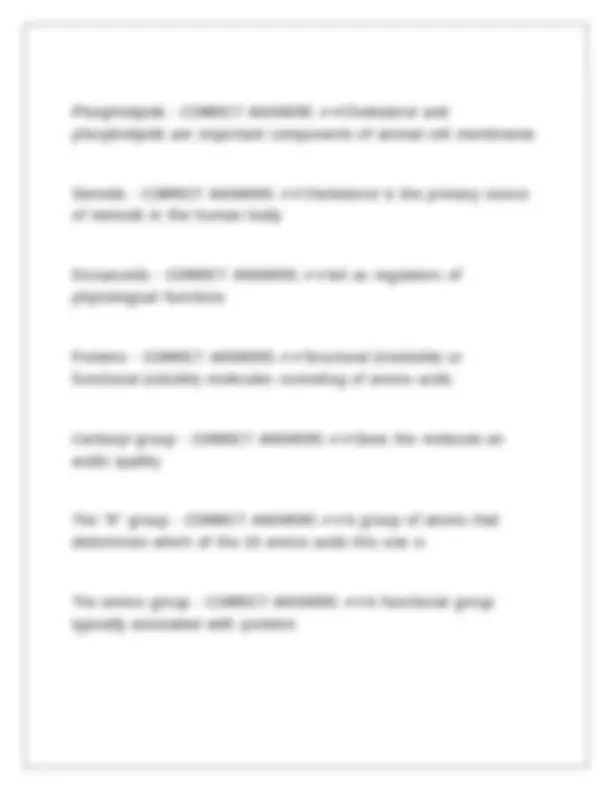
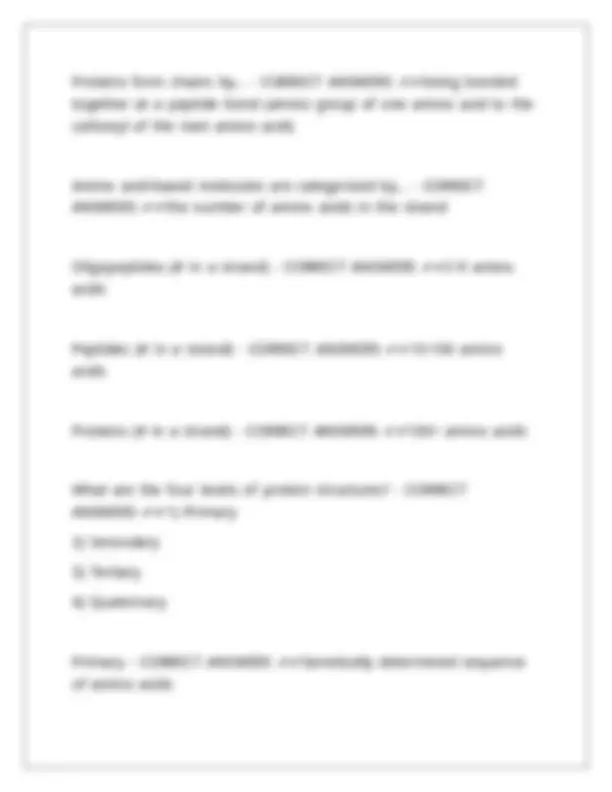
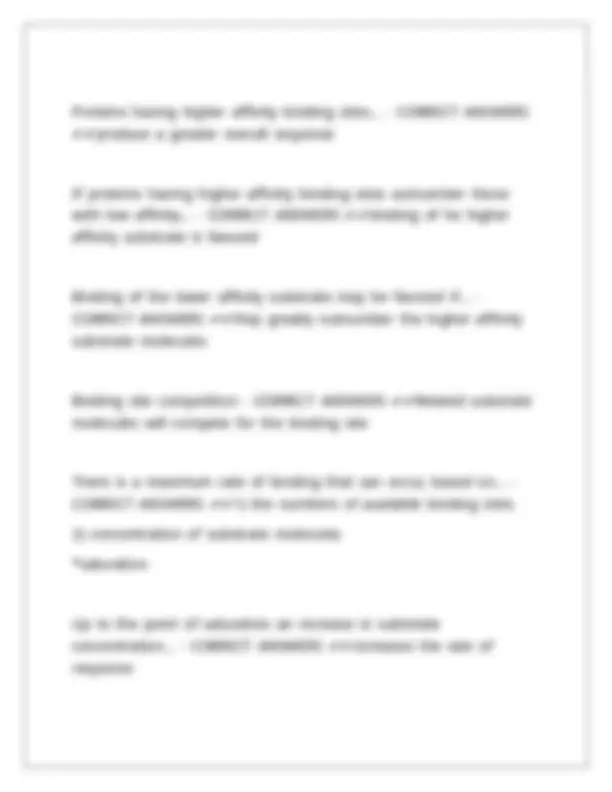
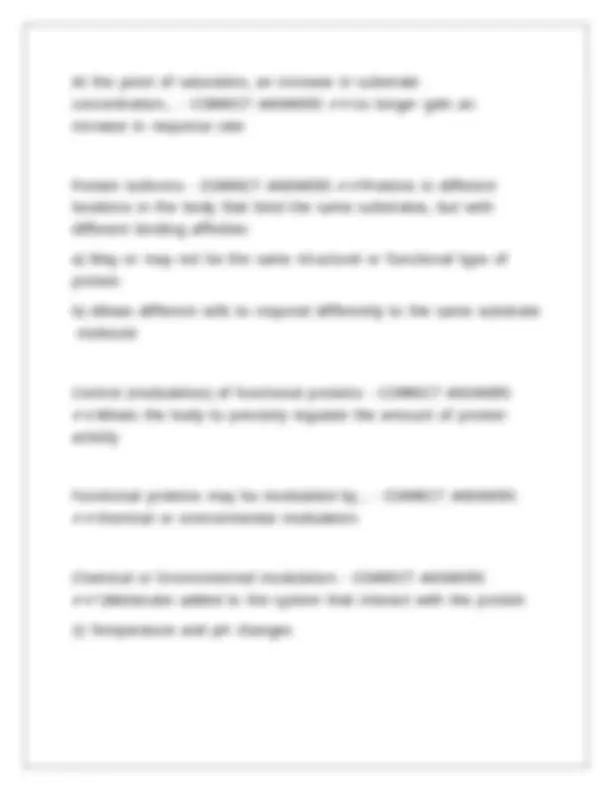
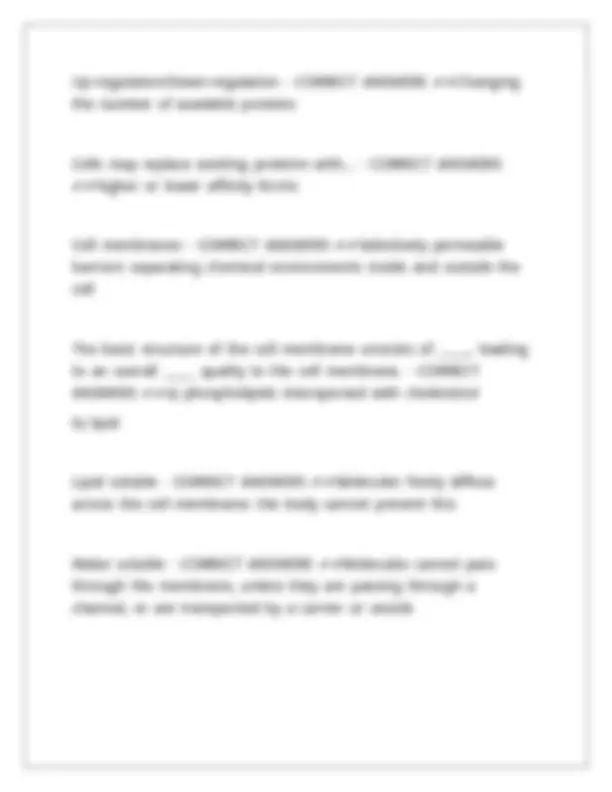
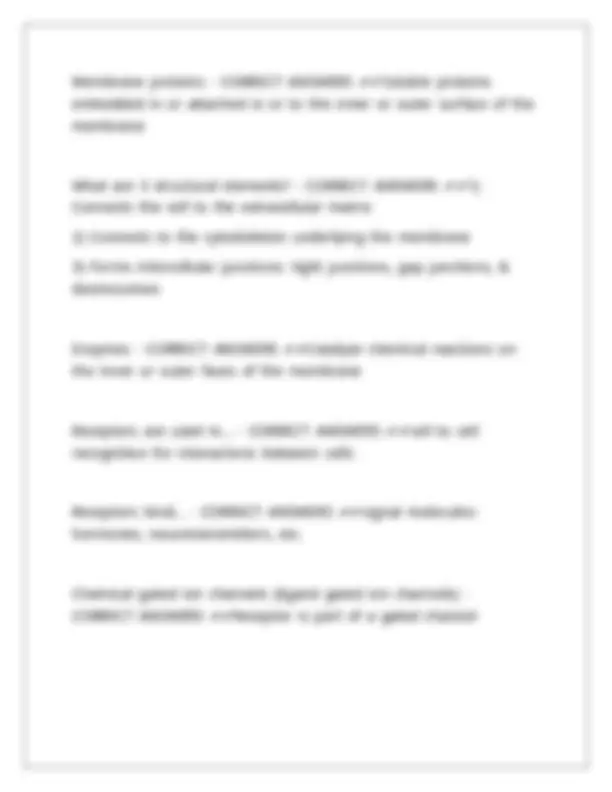
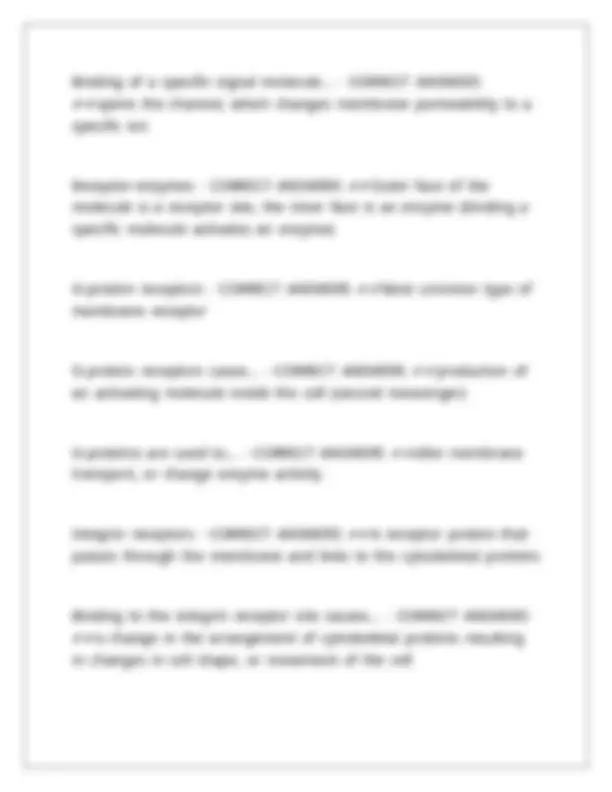
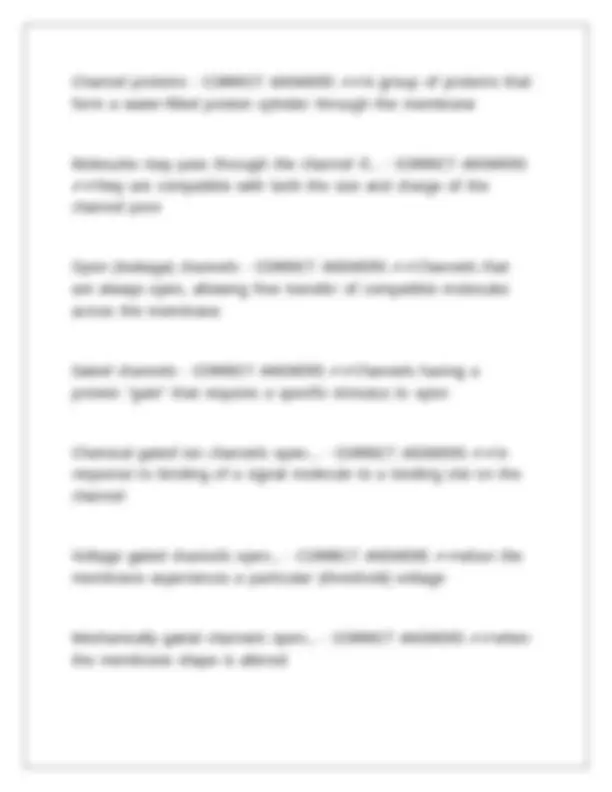
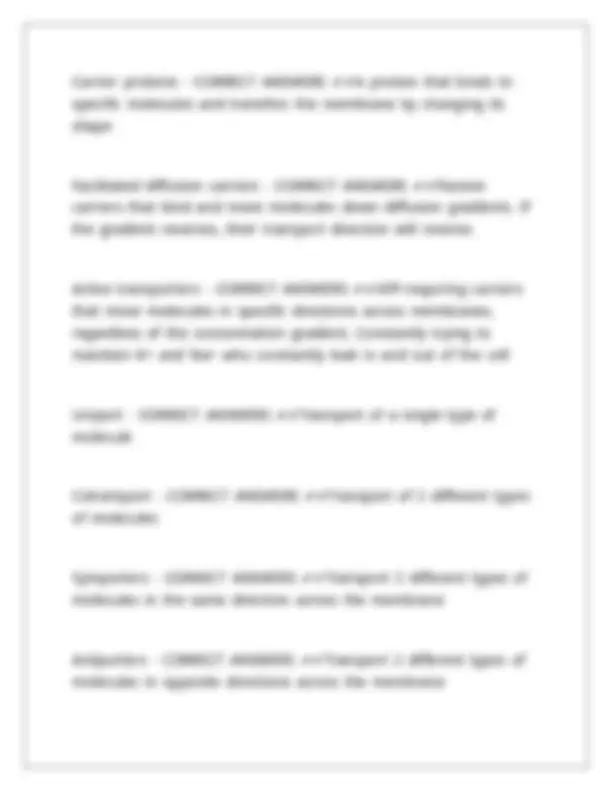
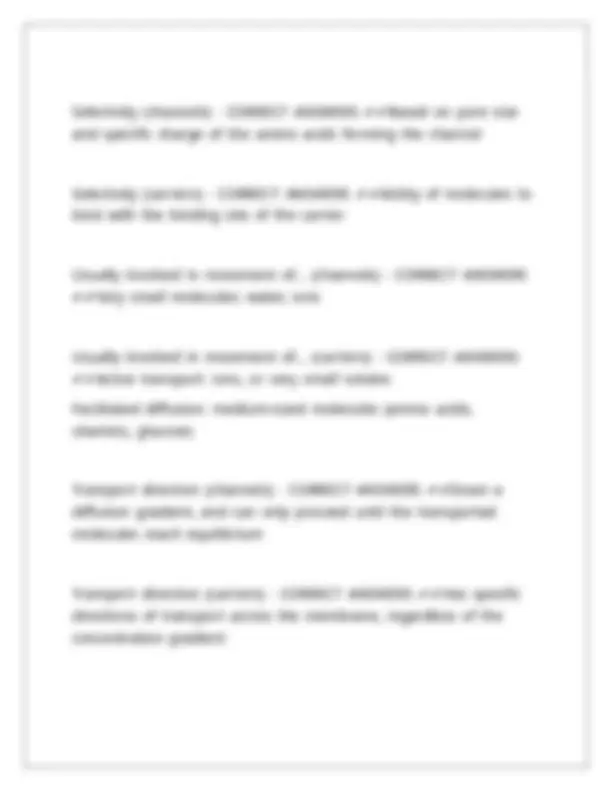
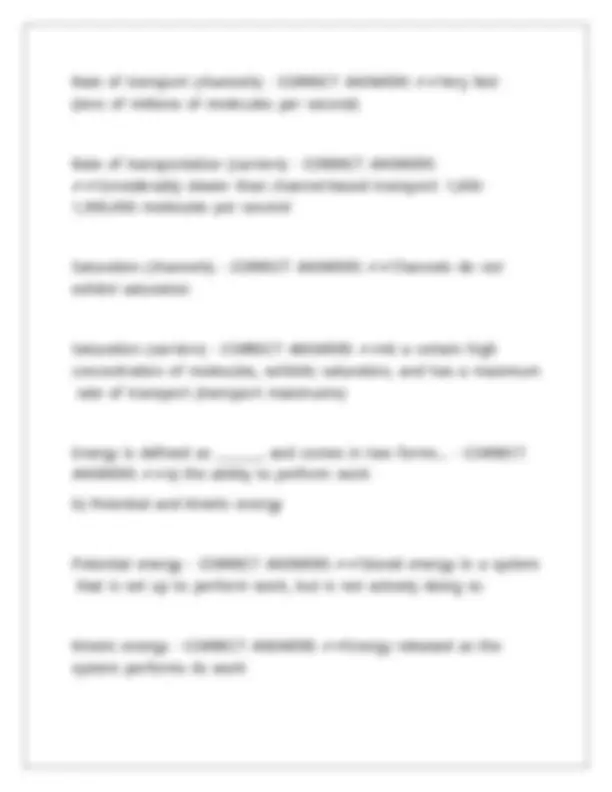
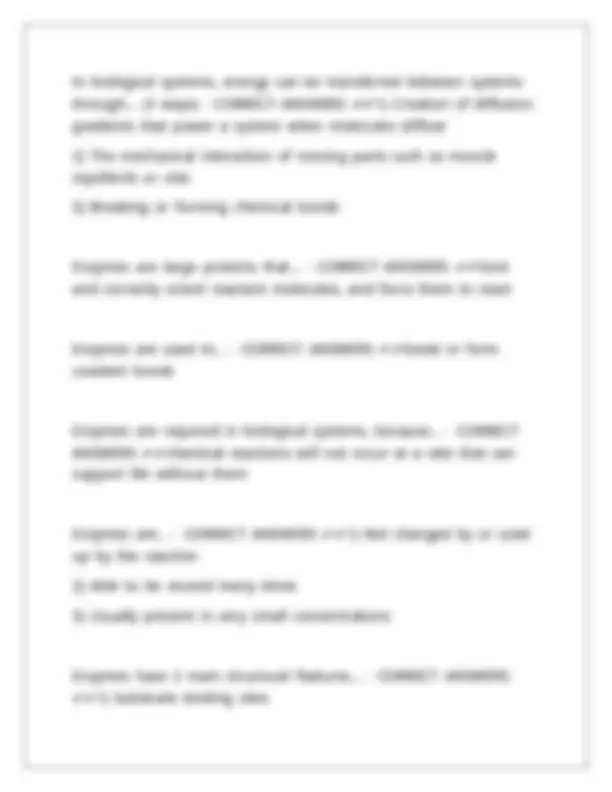
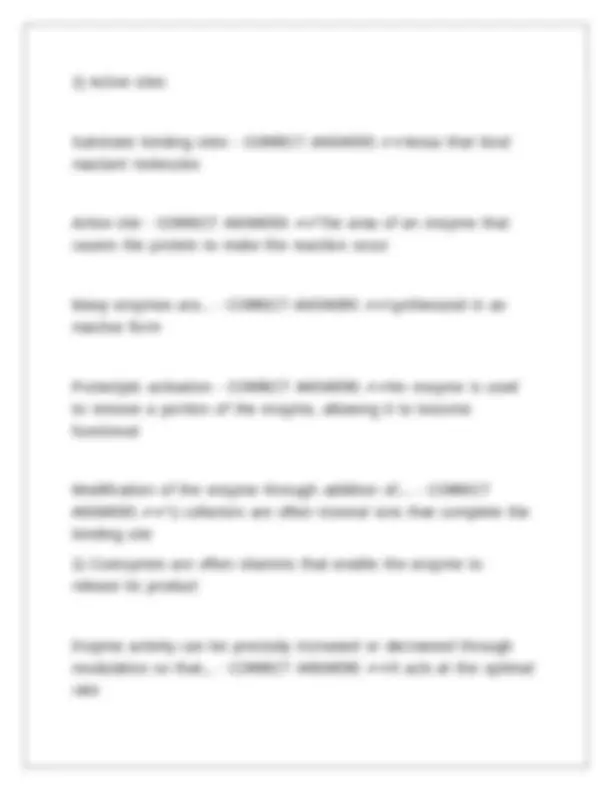
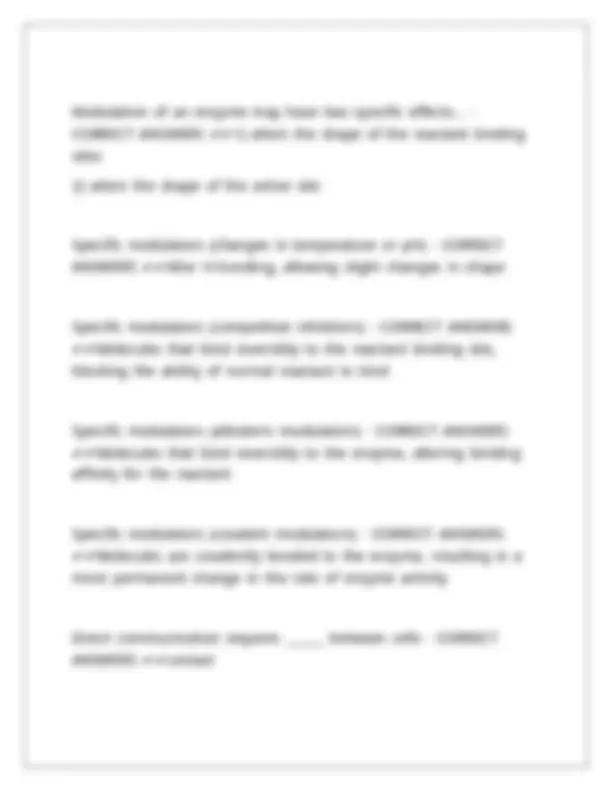
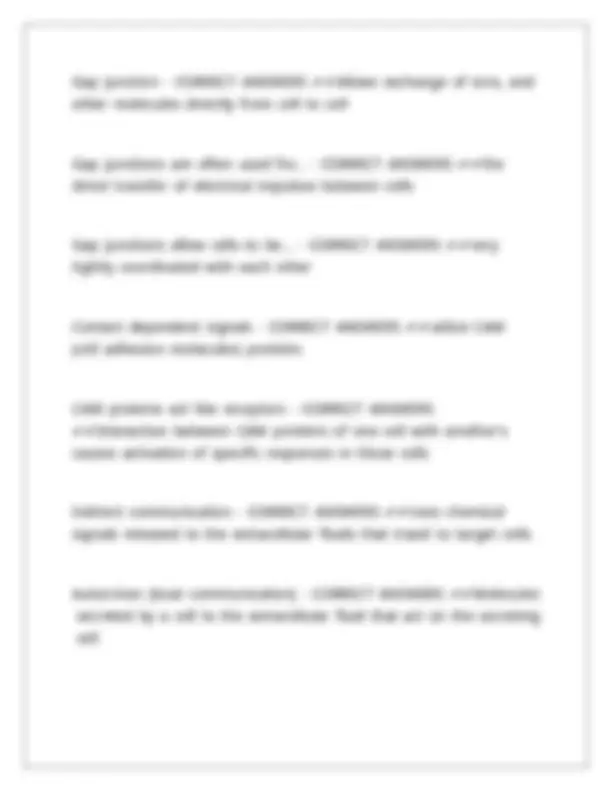
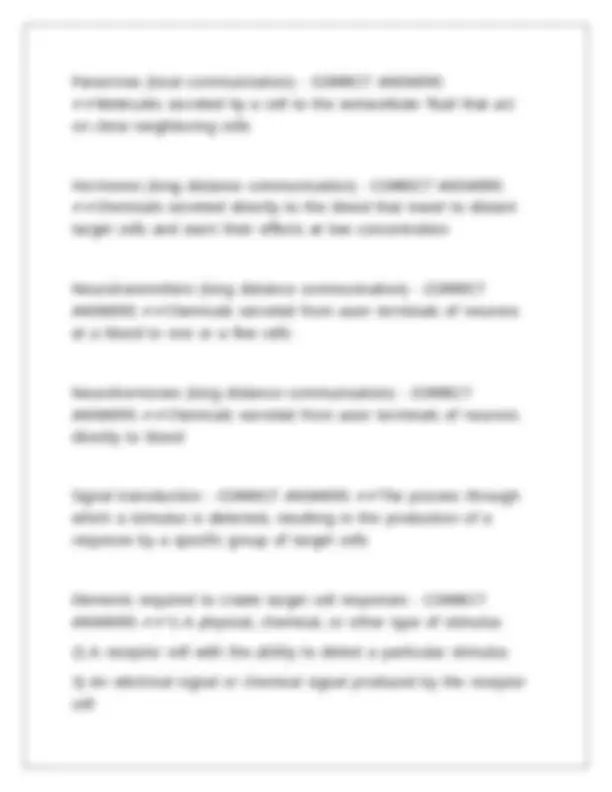
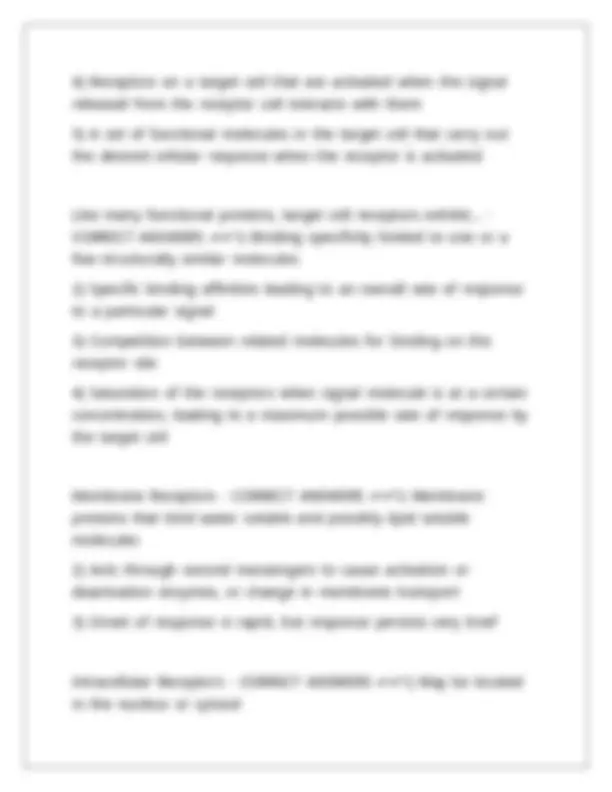
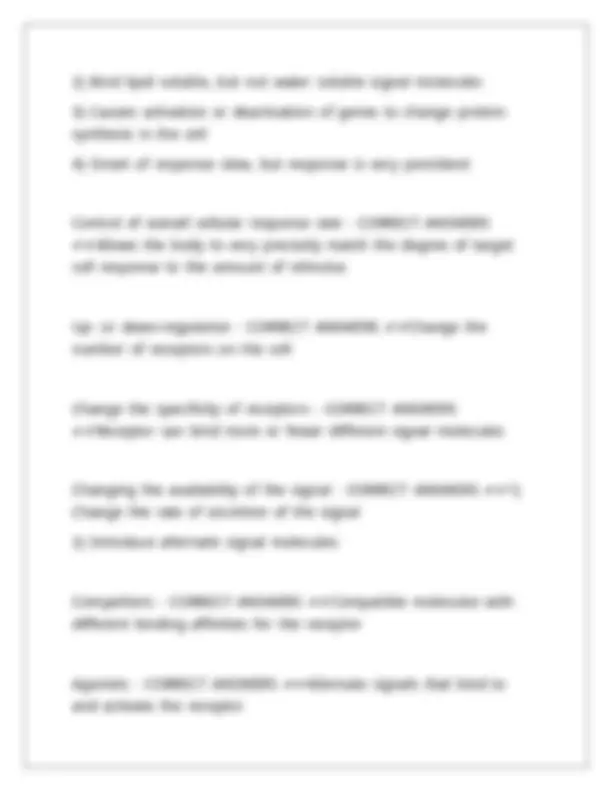
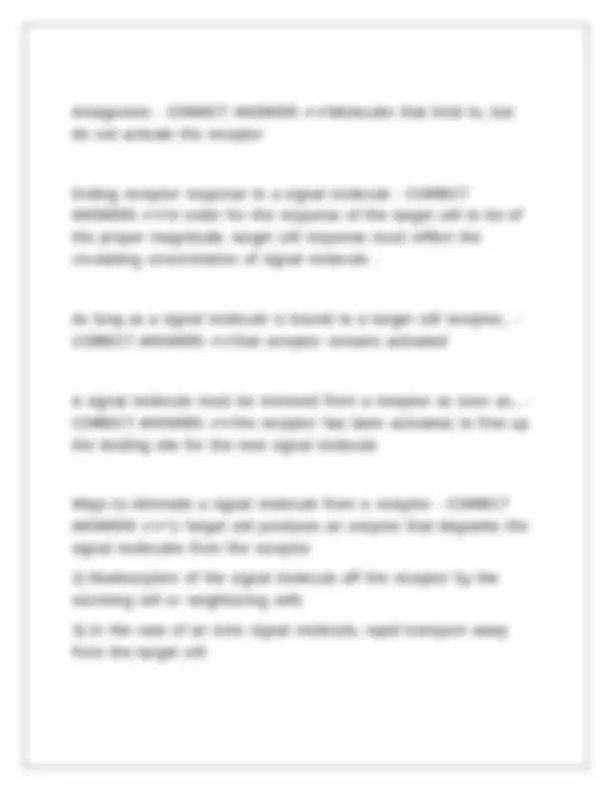
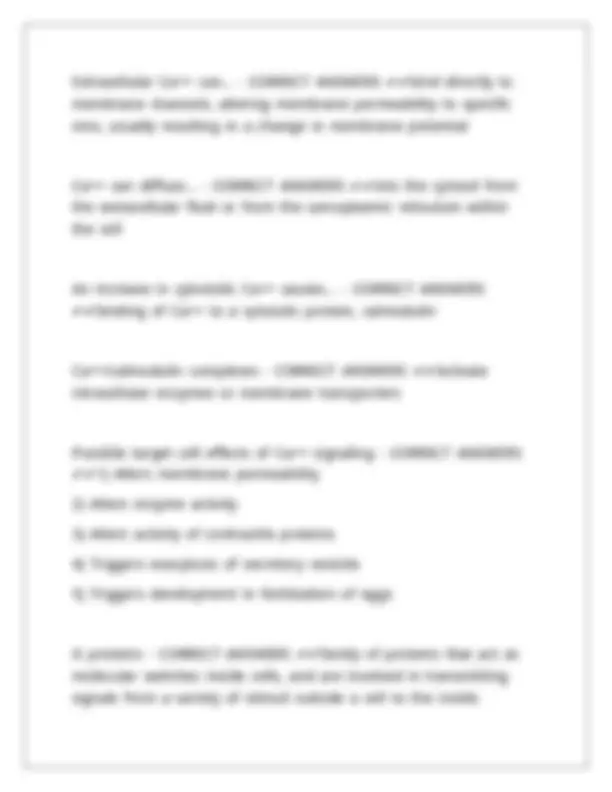


Study with the several resources on Docsity

Earn points by helping other students or get them with a premium plan


Prepare for your exams
Study with the several resources on Docsity

Earn points to download
Earn points by helping other students or get them with a premium plan
Community
Ask the community for help and clear up your study doubts
Discover the best universities in your country according to Docsity users
Free resources
Download our free guides on studying techniques, anxiety management strategies, and thesis advice from Docsity tutors
Ivy Tech APHY 201 Exam 1 questions with answers
Typology: Exams
1 / 35

This page cannot be seen from the preview
Don't miss anything!




























External |body |surfaces |are... |- |CORRECT |ANSWERS |✔✔continuous | with |the |external |environment What |are |the | 6 |external |body |surfaces? |- |CORRECT |ANSWERS |✔✔1) | Nasal |and |oral |passages
Primary |receptors |of |the |thirst |mechanism |- |CORRECT |ANSWERS | ✔✔Hypothalamic |receptor |neurons |signal |the |thirst |center |when | blood |plasma |osmolarity |> | 280 |mOsm Secondary |receptors |of |the |thirst |mechanism |- |CORRECT |ANSWERS | ✔✔Osmoreceptors |in |the |mouth |detect |low |volume |and |increase | concentration |of |saliva Integrating |center |- |CORRECT |ANSWERS |✔✔Hypothalamic |thirst | center Stimulation |of |the |thirst |center |causes... |- |CORRECT |ANSWERS |✔✔1) | Stimulation |of |water-seeking |behaviors |through |the |cerebral |cortex
Renal |response |- |CORRECT |ANSWERS |✔✔Cannot |fix |dehydration; | only |reduces |water |loss (reduces |filtrate |formation |and |increases |water |absorption |from | the |urine) Hypothalamic |compensations |for |overhydration |- |CORRECT | ANSWERS |✔✔Plasma |osmolarity |< | 280 |mOsm |strongly |inhibits | thirst |by |quieting |receptor |neurons Renal |Response |compensations |for |overhydration |- |CORRECT | ANSWERS |✔✔Increase |water |loss |in |urine |by |increasing |filtrate | formation |and |inhibiting |water |absorption |from |the |urine Homeostasis |- |CORRECT |ANSWERS |✔✔The |ability |of |the |body |to | maintain |optimal |performance |of |a |system |under |a |given |set |of | conditions When |conditions |of |homeostasis |change... |- |CORRECT |ANSWERS | ✔✔homeostatic |set |points |change |to |maintain |the |optimal | performance |of |the |system Feedback |loops |- |CORRECT |ANSWERS |✔✔Systems |that |allow | communication |between |cells |to |maintain |a |physiological |system | within |a |given |range |of |function
Examples |of |chemical |properties |- |CORRECT |ANSWERS |✔✔Size, | weight, |number |of |protons |or |electrons, |solubility |in |water, |electrical |charge Atom |- |CORRECT |ANSWERS |✔✔The |smallest |particle |of |any |element Proton |- |CORRECT |ANSWERS |✔✔Subatomic |particle |with |one | positive |charge |and |mass |of | 1 |amu |(located |in |the |nucleus) Neutron |- |CORRECT |ANSWERS |✔✔Subatomic |particle |with |no | charge |and |mass |of | 1 |amu |(located |in |the |nucleus) Electron |- |CORRECT |ANSWERS |✔✔A |subatomic |particle |with |a | negative |electric |charge |(located |in |orbitals |around |the |nucleus) Naturally |occurring |atoms |have... |- |CORRECT |ANSWERS |✔✔equal | numbers |of |positive |and |negative |charges The |number |of |protons |in |the |nucleus |determines... |- |CORRECT | ANSWERS |✔✔atomic |number What |do |different |numbers |of |neutrons |create? |- |CORRECT | ANSWERS |✔✔Isotope
Electrons |are |involved |in... |- |CORRECT |ANSWERS |✔✔Form |covalent | bonds, |gained |or |lost |create |ions, |capture |and |store |energy, |create | free |radicals The |molecular |weight |of |an |atom |is |determined |by... |- |CORRECT | ANSWERS |✔✔protons |+ |neutrons |= |atomic |mass Electron |compatibility |is |partly |determined |by... |- |CORRECT |ANSWERS |✔✔how |many |empty |spaces |exist |around |the |nuclei |of |the |bonding |atoms; |this |is |a |chemical |property |of |atoms Describe |the |energy |levels |of |electrons |based |on |their |position | relative |to |the |nucleus |- |CORRECT |ANSWERS |✔✔The |lowest |energy | level |starts |closest |to |the |nucleus |and |gets |stronger |farther |out What |happens |when |electrons |absorb |energy |from |the | environment? |- |CORRECT |ANSWERS |✔✔They |spin |faster, |the |faster | they |spin, |they |can |jump |into |a |higher |energy |level The |energy |content |of |larger |molecules |is |________ |smaller | molecules |- |CORRECT |ANSWERS |✔✔greater |than Forming |chemical |bonds |________ |energy |content |of |a |molecule |- | CORRECT |ANSWERS |✔✔increases
Ionic |bonds |- |CORRECT |ANSWERS |✔✔(AKA |electrostatic |attractions) | result |from |the |attraction |between |ions |with |opposite |charges What |happens |to |a |molecule |when |it |loses |an |electron? |- |CORRECT | ANSWERS |✔✔The |molecule |becomes |positive What |happens |to |a |molecule |when |it |gains |and |electron? |- | CORRECT |ANSWERS |✔✔The |molecule |becomes |negative Cations |- |CORRECT |ANSWERS |✔✔Positively |charged |ions Anions |- |CORRECT |ANSWERS |✔✔Negatively |charged |ions Hydrogen |bonds |- |CORRECT |ANSWERS |✔✔A |weak |attractive |force | between |a |hydrogen |atom |and |a |nearby |oxygen, |nitrogen, |or | fluorine |atom. |No |electrons |are |gained, |lost, |or |shared. What |is |the |basic |chemical |formula |for |carbohydrates? |- |CORRECT | ANSWERS |✔✔CH2O What |are |carbohydrates |used |for |by |the |body? |- |CORRECT |ANSWERS |✔✔To |store |chemical |of |energy |or |in |the |manufacture |of |chemical | energy
Monosaccharide |- |CORRECT |ANSWERS |✔✔The |building |blocks |of | complex |carbohydrates |can |either |have | 5 |carbons |(ribose) |or | 6 | carbons |(glucose) Disaccharide |- |CORRECT |ANSWERS |✔✔Consist |of |glucose |plus | another |monosaccharide |(made |from | 2 |simple |sugars) Polysaccharide |- |CORRECT |ANSWERS |✔✔Glucose |polymers. |All |living | cells |store |glucose |for |energy |in |the |form |of |a |polysaccharide Provide |examples |for |polysaccharides |and |what |kind |of |organism | possesses |each |example |you |give: |- |CORRECT |ANSWERS |✔✔Chitin | (in |invertebrate |animals), |glycogen |(in |vertebrate |animals), |cellulose | and |starch |(in |plants), |dextran |(in |bacteria |and |yeast) Nucleotides |- |CORRECT |ANSWERS |✔✔Biomolecules |that |play |an | important |role |in |energy |and |info |transfer What |are |the | 3 |basic |structures |of |a |nucleotide? |- |CORRECT | ANSWERS |✔✔1) |ATP |(adenosine |triphosphate)
How |many |tails |are |in |a |disaccharide |(lipids)? |- |CORRECT |ANSWERS | ✔✔two How |many |tails |are |in |a |triglyceride |(lipids)? |- |CORRECT |ANSWERS | ✔✔three What |is |the |most |prevalent |form |of |true |lipids |in |the |human | body? |- |CORRECT |ANSWERS |✔✔Cholesterol Describe |the |glycerol |subunit |- |CORRECT |ANSWERS |✔✔Glycerol |is |a | simple |3-carbon |molecule |that |makes |up |the |back |bone |of |most | lipids Describe |the |fatty |acid |subunit |- |CORRECT |ANSWERS |✔✔Long |chains |of |carbon |atoms |bound |to |hydrogens |with |a |carboxyl |(-COOH) | or |"acid" |group |at |one |end |of |the |chain Saturated |fatty |acids |- |CORRECT |ANSWERS |✔✔No |double |bonds | between |carbons, |so |they |are |"saturated" |with |hydrogens. |More | fatty |acids |= |more |likely |to |be |solid |at |room |temp Unsaturated |fatty |acids |- |CORRECT |ANSWERS |✔✔Have |one |or |more | double |bonds |between |carbons |in |the |chain
Phospholipids |- |CORRECT |ANSWERS |✔✔Cholesterol |and | phospholipids |are |important |components |of |animal |cell |membranes Steroids |- |CORRECT |ANSWERS |✔✔Cholesterol |is |the |primary |source | of |steroids |in |the |human |body Eicosanoids |- |CORRECT |ANSWERS |✔✔Act |as |regulators |of | physiological |functions Proteins |- |CORRECT |ANSWERS |✔✔Structural |(insoluble) |or | functional |(soluble) |molecules |consisting |of |amino |acids Carboxyl |group |- |CORRECT |ANSWERS |✔✔Gives |the |molecule |an | acidic |quality The |"R" |group |- |CORRECT |ANSWERS |✔✔A |group |of |atoms |that | determines |which |of |the | 20 |amino |acids |this |one |is The |amino |group |- |CORRECT |ANSWERS |✔✔A |functional |group | typically |associated |with |proteins
Secondary |- |CORRECT |ANSWERS |✔✔Spatial |arrangement |of |amino | acids |in |the |strand Secondary |spatial |arrangement |determined |by... |- |CORRECT | ANSWERS |✔✔the |best |fit |between |R |groups |of |individual |amino | acids |in |the |strand Secondary |forms |- |CORRECT |ANSWERS |✔✔Either |alpha |helices | (spiral |shapes), |or |beta |pleated |sheets |(accordion |folded |sheets) Tertiary |- |CORRECT |ANSWERS |✔✔3D |arrangement |of |alpha |helices | and |beta |pleated |sheets Tertiary |forms |- |CORRECT |ANSWERS |✔✔Either |globular |(ball-like) |or | fibrous |(strand-like) |shapes Quaternary |- |CORRECT |ANSWERS |✔✔3D |arrangement |of |subunits | that |have |a |tertiary |level |of |structure Quaternary |forms |- |CORRECT |ANSWERS |✔✔Either |globular |or | fibrous |shapes
Most |functional |proteins |bind... |- |CORRECT |ANSWERS |✔✔reversibly | to |other |molecules |(there |will |be |an |equilibrium |between |the | proportion |of |bound |and |unbound |molecules) What |does |the |addition |or |removal |of |molecules |that |can |bind |to |a | protein |do? |- |CORRECT |ANSWERS |✔✔Changes |the |binding |behavior | of |the |protein If |the |free |(unbound) |concentration |of |molecules |increases, |then... |- | CORRECT |ANSWERS |✔✔some |of |the |free |molecules |will |be |bound |to |the |binding |protein If |the |free |concentration |of |molecules |decreases, |then... |- |CORRECT | ANSWERS |✔✔some |bound |molecules |unbind |from |the |protein, | becoming |part |of |the |free |concentration Specificity |- |CORRECT |ANSWERS |✔✔A |binding |site |is |specifically | shaped |to |fit |one |or |a |small |group |of |structurally |similar |molecules Substrate |molecules |- |CORRECT |ANSWERS |✔✔Molecules |that |bind | to |a |binding |site |on |a |protein Affinity |- |CORRECT |ANSWERS |✔✔Some |molecules |will |have |a | stronger |attraction |for |the |binding |site |than |others
At |the |point |of |saturation, |an |increase |in |substrate | concentration... |- |CORRECT |ANSWERS |✔✔no |longer |gets |an | increase |in |response |rate Protein |isoforms |- |CORRECT |ANSWERS |✔✔Proteins |in |different | locations |in |the |body |that |bind |the |same |substrates, |but |with | different |binding |affinities a) |May |or |may |not |be |the |same |structural |or |functional |type |of | protein b) |Allows |different |cells |to |respond |differently |to |the |same |substrate |molecule Control |(modulation) |of |functional |proteins |- |CORRECT |ANSWERS | ✔✔Allows |the |body |to |precisely |regulate |the |amount |of |protein | activity Functional |proteins |may |be |modulated |by... |- |CORRECT |ANSWERS | ✔✔chemical |or |environmental |modulators Chemical |or |Environmental |modulators |- |CORRECT |ANSWERS | ✔✔1)Molecules |added |to |the |system |that |interact |with |the |protein
Up-regulation/Down-regulation |- |CORRECT |ANSWERS |✔✔Changing | the |number |of |available |proteins Cells |may |replace |existing |proteins |with... |- |CORRECT |ANSWERS | ✔✔higher |or |lower |affinity |forms Cell |membranes |- |CORRECT |ANSWERS |✔✔Selectively |permeable | barriers |separating |chemical |environments |inside |and |outside |the | cell The |basic |structure |of |the |cell |membrane |consists |of |_____, |leading | to |an |overall |_____ |quality |to |the |cell |membrane. |- |CORRECT | ANSWERS |✔✔a) |phospholipids |interspersed |with |cholesterol b) |lipid Lipid |soluble |- |CORRECT |ANSWERS |✔✔Molecules |freely |diffuse | across |the |cell |membrane: |the |body |cannot |prevent |this Water |soluble |- |CORRECT |ANSWERS |✔✔Molecules |cannot |pass | through |the |membrane, |unless |they |are |passing |through |a | channel, |or |are |transported |by |a |carrier |or |vesicle